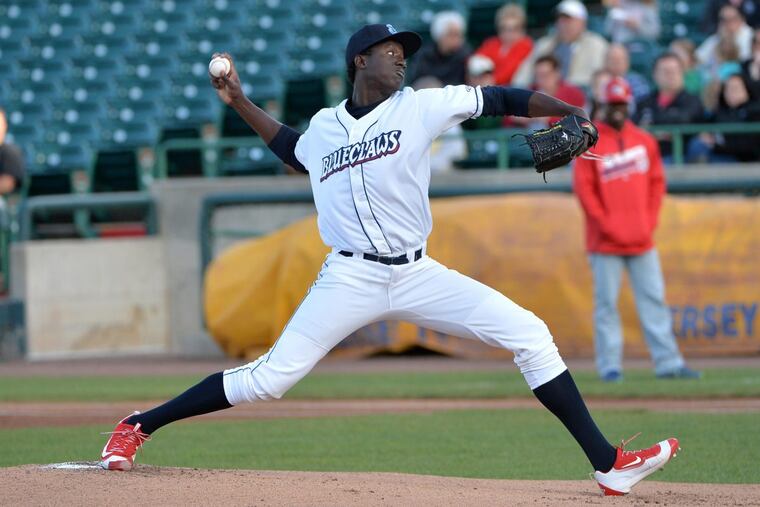Phillies want to develop starting pitchers; here are four to watch
The success of the Phillies rebuild will likely hinge on the team's ability to develop starting pitchers. Jose Taveras and Franklyn Kilome are among those worth watching.

"Maybe never in our history has it been more important to develop starting pitchers." — Phillies general manager Matt Klentak on Dec. 13 at the winter meetings
The Phillies have made it clear — dating as far back to president Andy MacPhail's introductory news conference in 2015 — that they would much prefer to be in the business of developing starting pitchers than acquiring them.
They have committed a combined $94 million this winter on three free agents — first baseman Carlos Santana and relievers Pat Neshek and Tommy Hunter — and could very well add a starting pitcher before spring training begins next month. But acquiring starting pitching is both expensive, in terms of free-agent salary or the bounty of a trade, and difficult, as teams don't want to part with their arms. That is why the Phillies would rather groom their own.
The success of the Phillies' rebuild likely will hinge on the team's ability to develop starting pitchers. Aaron Nola seems to be a success, but the rest is uncertain. There's a collection of pitchers, most of whom will start the season at double A or lower, from which the Phillies are hoping a reliable starter or two will emerge. Here are four prospects — besides the obvious No. 1 prospect, Sixto Sanchez — to watch in 2018.
RHP Jose Taveras. The Phillies added Taveras to the 40-man roster in December after he led all Phillies minor leaguers in strikeouts the past two seasons. The 24-year-old throws a low-90s fastball but relies more on his changeup and curveball. Taveras struck out 140 last season and walked 39 in 154 1/3 innings as he moved from high A to double A to triple A. He ended the season with a dominant stretch at triple A, and it will be interesting to see if the Phillies start him there in April.
"He knows how to get guys out, and oftentimes that comes via the strikeout," Klentak said. "No matter where he pitches, he rises to the occasion and puts up a strong performance."
RHP Franklyn Kilome. There's been a buzz around Kilome for the last few minor-league seasons, and it's easy to understand why. He's 6-foot-6 with an electric fastball that sits in the high 90s. He has a dependable curveball and slider and a developing changeup. Kilome, 22, has the tools to be a pitcher the Phillies can develop, and he flashed that potential last season between high-A Clearwater and double-A Reading. Kilome struck out 103 and walked 52 in 127 innings last year. He will start the season in a Reading rotation that likely will include Ranger Suarez — whom Klentak labeled as last season's "breakout pitcher of the year" — and JoJo Romero, who had a strong season last year for single-A Lakewood and Clearwater.
"He's got the size and stuff to be a really good major-league pitcher," Klentak said of Kilome. "He still needs refinement, but he has tons of tools."
RHP Tom Eshelman. Eshelman, 23, won the Paul Owens Award, given to the organization's top minor-league pitcher, after posting a 2.40 ERA last season in 150 innings in double A and triple A. Expect him to get an invitation to major-league spring training and be a wild card for the starting rotation if the Phillies do not add a starter before camp. Eshelman, who has a command of the strike zone that the Phillies love, will be one of the first starters called to Philly if he starts the season at triple A. He struck out 80 and walked just 13 in 121 triple-A innings last season. Klentak wants both his batters and pitchers to control the strike zone. Eshelman fits that mold.
"Tom was a model of consistency for the entire 2017 season," Phillies director of player development Joe Jordan said upon honoring Eshelman with the Owens Award. "His ability to execute pitches is truly special, and his ability to command the baseball is going to allow him to be a meaningful rotation piece for our major-league club going forward."
RHP Connor Seabold. Seabold worked as a reliever last season at short-season Class A Williamsport as the Phillies managed his innings after his final season at Cal State-Fullerton. Seabold, who will turn 22 later this month, shapes up to be a candidate for the starting rotation at Class A Lakewood. He walked just 23 in 127 2/3 innings in college last season. He matches a low-90s fastball with a solid changeup and curveball. The reasons for excitement around Eshelman — consistent strike thrower, strong mechanics — are the same for Seabold. And it's fitting that the two were college teammates in 2015.
"He's a lot like Eshelman but with a lot more stuff," amateur scouting director Johnny Almaraz said after drafting Seabold in the third round last June. "He has more power to him. He's a very good pitcher. He's somebody that could be a very quick mover."